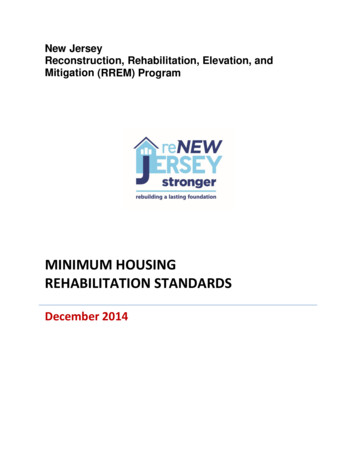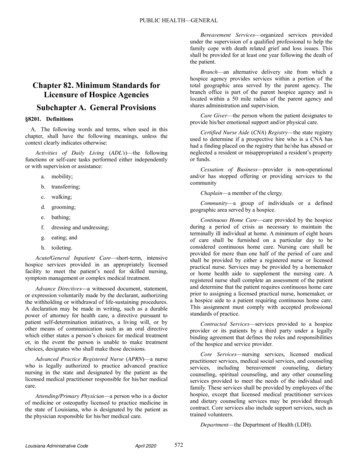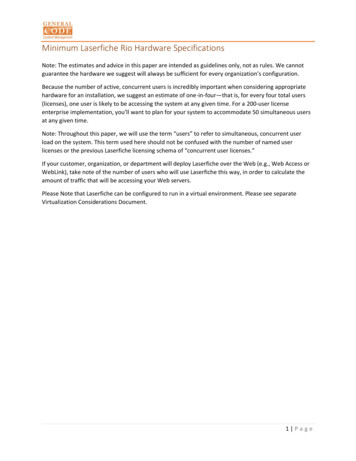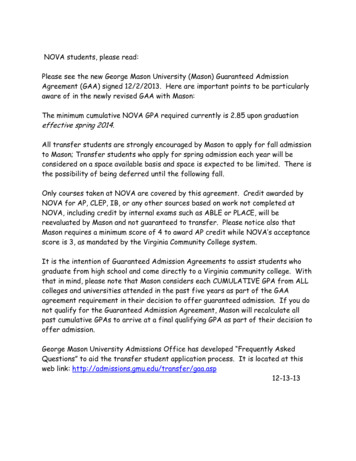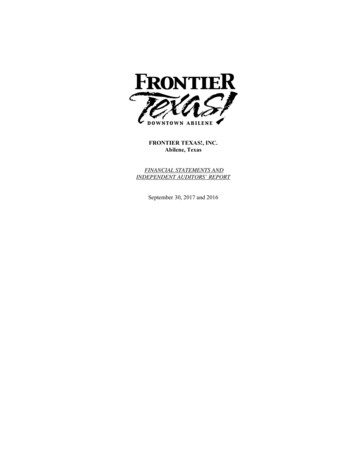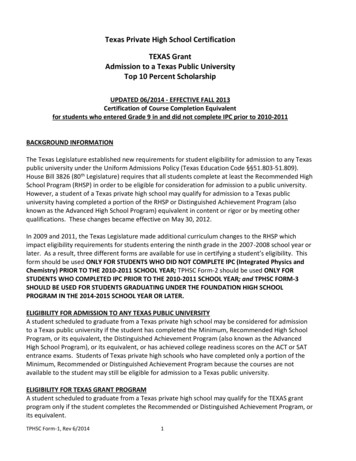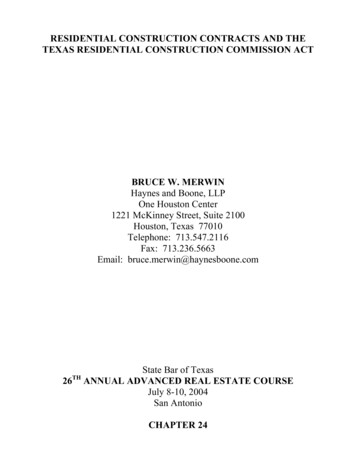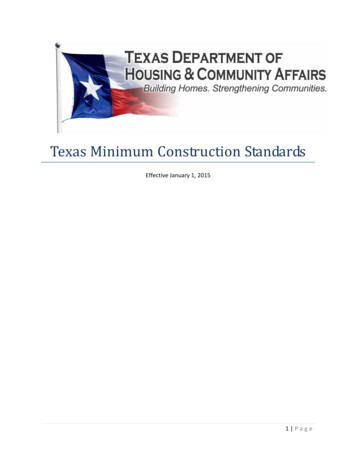
Transcription
Texas Minimum Construction StandardsEffective January 1, 20151 Page
ContentsChapter 1: Administration and General Requirements . 51.1Definitions . 51.2Background, Purpose, Intent and Disclaimer. 51.3Qualifications and Workmanship. 51.4Initial Inspections . 61.5Substandard Conditions . 61.6Structural Integrity . 61.7Nonessential Improvements and Cosmetic Improvements . 71.8Lead-Based Paint. 71.9Asbestos . 71.10Historic Properties . 71.11Proposed Scopes of Work and Cost Estimates . 81.12Contractor Requirements . 81.13General Specifications. 91.14Walk Away Policy . 101.15Useful Life of Major Systems . 101.16Authority and Enforcement . 10Chapter 2: Site Work . 112.1General Requirements . 112.2Debris and Brush Removal . 112.3Drainage . 112.4Driveways, Sidewalks and Patios . 112.5Sanitary Drainage . 122.6Water Supply. 122.7Ramps. 122.8Vermin and Insects. 122.9Landscaping for New Construction and Additions. 13Chapter 3: Foundations . 133.1General Requirements . 133.2Determining the Scope of Work . 133.3Substandard Conditions . 142 Page
3.4Slab on Grade . 143.5Pier and Beam . 14Chapter 4: Electrical Systems . 144.1General Requirements . 144.2Determining the Scope of Work . 154.3Substandard Conditions . 164.4Existing Wiring and Fixtures . 164.5Sizing of Service and All Electric Homes. 174.6Material and Equipment Installation . 174.7Grounding . 174.8Overcurrent Protection . 184.9Service Panel and Sub-panel Connections . 184.10Branch Circuits . 184.11Receptacles . 194.12Fixtures and Switches . 204.13Smoke and Carbon Monoxide Detectors . 21Chapter 5: Plumbing Systems . 215.1General Requirements . 215.2Determining the Scope of Work . 215.3Substandard Conditions . 225.4Water Supply. 235.5Sanitary Drainage . 235.6Plumbing Fixtures. 255.7Domestic Water Heaters (DWH) . 25Chapter 6: Heating, Ventilation, and Air Conditioning Systems (HVAC). 266.1General Requirements . 266.2Determining the Scope of Work . 266.3Substandard Conditions . 276.4Sizing and Selecting a New System . 276.5Distribution System . 286.6Ventilation and Indoor Air Quality . 29Chapter 7: Roofing Systems and Attics . 307.1General Requirements . 307.2Determining the Scope of Work . 307.3Substandard Conditions . 303 Page
7.4Structure . 317.5Roof Covering . 317.6Gutters and Downspouts . 32Chapter 8: Walls and Ceilings. 328.1General Requirements . 328.2Determining the Scope of Work . 328.3Substandard Conditions . 338.4Walls. 338.5Ceilings . 338.6Painting and Finishes . 34Chapter 9: Flooring . 349.1General Requirements . 349.2Determining the Scope of Work . 359.3Substandard Conditions . 359.4Subfloor . 359.5Floor Coverings . 36Chapter 10: Doors and Windows . 3610.1General Requirements . 3610.2Determining the Scope of Work . 3710.3Substandard Conditions . 3710.4Doors . 3710.5Windows . 3810.6Painting and Finishes . 39Chapter 11: Energy Efficiency . 3911.1Rehabilitation . 39Chapter 12: Miscellaneous. 4012.1Kitchens . 404 Page
Chapter 1: Administration and General Requirements11.1DefinitionsThe capitalized terms used herein may be defined in the Single Family Umbrella Rule found inthe Texas Administrative Code (TAC), Title 10, Part I, Chapter 20, the specific program rule inTitle 10, or in the specific program NOFA, or the applicable federal regulations.In addition, these standards serve as a starting point for Rehabilitation of Single Familydwellings. Additional and more detailed construction requirements may be outlined in theagreement, Contract or loan documents.1.2Background, Purpose, Intent and DisclaimerThe Texas Department of Housing and Community Affairs (TDHCA) developed the TexasMinimum Construction Standards (TMCS) to be the primary document for identifying andcorrecting substandard conditions in homes to be rehabilitated through TDHCA Single FamilyPrograms.The purpose of this document is to identify requirements for Rehabilitation while promotinghealthy, safe and decent housing for Texas low- to moderate- income households. All singlefamily dwellings being rehabilitated with funding subject to the Construction Requirements ofthe Single Family Umbrella Rule shall comply with TMCS as well as State and local codes,ordinances, and zoning requirements, as applicable.The intent of TMCS is to remedy health and safety defects, particularly life threateningdeficiencies. TMCS also supports the goals of Texas Government Code 2306 to provide for thehousing needs of individuals and families of low, very low, and extremely low income andfamilies of moderate income. TMCS outlines the minimal level of work required, and methodsand materials for rehabilitation work in order for the Department to evaluate and determinethat rehabilitation work complies with TMCS.Only items, components, or systems included in the construction contract funded by TDHCAmust comply with TMCS.TMCS is not the only construction standard necessary for Rehabilitation work. TMCS does notinclude all applicable building codes, materials, accessibility standards or installation methodswhich apply to Rehabilitation.TDHCA encourages the reproduction and distribution of this document to all relevant partiesparticipating in Rehabilitation, including staff, general contractors, and subcontractors. TMCSmust be included in all procurement documents by reference, but specific sections may becopied directly into bid documents.1.3Qualifications and WorkmanshipAdministrators shall ensure that all persons involved in TDHCA funded single familyRehabilitations are qualified for their tasks. If a homeowner, occupant, or volunteers performportions of the Rehabilitation, Administrators are responsible for ensuring that they aresufficiently qualified to perform the work identified and completed in a manner consistent withTMCS (a promise with the intent to complete work is not acceptable). If the nature of the work1Code references throughout this document are provided as guidance. All code references are to the 2009International Residential Code for One- and Two-Family Dwellings found -2009-000002.htm?bu2 IC-P-2009-0000195 Page
requires an individual to be licensed or certified, the Administrator must ensure that thosecontractors meet State licensing requirements. Employing and contracting with qualified andexperienced individuals is crucial to success. Administrators must have policies and proceduresin place to ensure that those responsible for inspecting homes, preparing work specifications,estimating costs, providing construction management, and contractors that do the work ofRehabilitation are qualified and experienced. Requirement to follow TMCS must be included inall Rehabilitation contracts.1.4Initial InspectionsDetailed initial inspections are required as the first step in rehabilitating a home. Allsubstandard conditions must be identified in the initial inspection and accompanied by asufficient number of photos to clearly identify the deficiency. In addition, conditions in which afuture deficiency may develop must also be identified, and where relevant, the housing must beimproved to mitigate the impact of potential disasters (e.g., earthquake, hurricanes, flooding, andwildfires) in accordance with State and local codes, ordinances, and requirements. As a generalrule, if a system or component is nearing the end of its Useful Life as defined below, it shall beidentified as a deficiency on the initial inspection report (e.g. the domestic water heater is stillfunctional but nearly the end of its Useful Life shall be identified as a deficiency andreplacement a part of the proposed scope of work). For single family homeownership “UsefulLife” is defined as having at least five (5) remaining years of safe and functional operation, forfederally funded rental housing projects of less than 15 units it is defined as the time of thefederal affordability period.1.5Substandard ConditionsThe intent of TMCS is to correct substandard conditions so that dwellings are safer, healthier,more durable, more affordable, more energy efficient and more habitable. Rehabilitation mustaddress more than those conditions that threaten the immediate health and safety of occupantsand future hazards. Each work specification must address at least one of the following to beconsidered an eligible expense:Remedy health and/or safety deficienciesImprove the comfort of one or more occupants, including energy efficiency standardsImprove accessibilityMeet local code or ordinancesAddress a critical need for storage or living spaceProtect the structural integrity of the dwellingReplacement of systems or components nearing the end of their Useful Life1.6Structural IntegrityA home that has sustained substantial structural damage shall be evaluated by a licensedstructural engineer to determine the necessary corrective measures. The engineer’s report shalldetermine if the home’s load bearing elements can be rehabilitated if a home has partiallycollapsed, moved off its foundation, lacks support of the ground necessary to support it, or ifthere exists a significant risk of collapse, detachment or dislodgement of any portion. Loadbearing elements include any column, girder, beam, joist, truss, rafter, wall, floor or roof deckingthat supports any vertical load in addition to its own weight or any lateral load.6 Page
1.7Nonessential Improvements and Cosmetic ImprovementsA nonessential improvement is an unnecessary item or measure intended solely for convenienceor increasing the property value that does not directly relate to the correction of a substandardcondition or extending the Useful Life of the property. Non-essential improvements that do noteliminate a hazard or remedy a deficiency shall not become a part of Rehabilita
the Texas Administrative Code (TAC), Title 10, Part I, Chapter 20, the specific program rule in Title 10, or in the specific program NOFA, or the applicable federal regulations. In addition, these standards serve as a star
